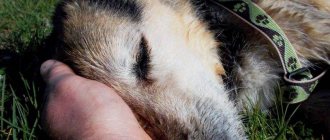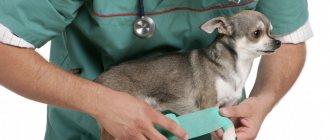No matter how much we love and are attached to our smaller brothers, unfortunately, sooner or later, like all living beings, animals go to another world. Death, even in relation to dogs, is a truly sad reality that all, without exception, breeders of these beautiful creatures devoted to us will have to face. But so that the death of a pet does not become a sudden blow, we will consider the signs of approaching extinction, by which you can understand that the dog is dying. Perhaps this knowledge will at least help you mentally prepare for the calm departure of your beloved dog.
What do dogs die from?
The appearance of a pet in the house is not only a joyful, but a responsible event. From the first days, the pet needs proper systematic care, attention, care and love.
Important! The duration and quality of life of our little brothers largely depends on the actions and attitude of the owner and family members towards the animal.
We need to understand that our pets live much shorter lives than people. The average lifespan of a dog is 10-13 years. There are cases where dogs lived up to 17-18 years. But these indicators are individual for each specific animal and the life of a pet can end at any moment.
At the same time, representatives of large, giant, medium breeds can live only 9-11 years, small dogs live 12-14 years. Life expectancy depends not only on the breed, but also on many other reasons (care, health status).
Dogs die:
- from old age;
- viral-bacterial, infectious diseases;
- invasive diseases;
- incurable infections;
- cancer;
- autoimmune, advanced chronic pathologies;
- congenital, genetic abnormalities.
Often the cause of death for dogs is severe injuries, injuries incompatible with life. Puppies, young dogs, unvaccinated pets can die from diseases (viral, bacterial) if treatment is not started in time. However, most diseases of infectious etiology develop at lightning speed, and the dog should be treated immediately after the first symptoms appear. Some diseases can only be cured at an early stage of their development.
Dogs die from poisoning from poisons, potent toxins, chemicals, and medications. Therefore, to prevent this from happening, keep medicines and medicines at home in places inaccessible to dogs, and on walks, make sure that the dog does not pick up crap from the ground.
Respiratory arrest/cardiac arrest
Primary resuscitation measures should be started when the animal is unconscious. Artificial respiration is the most important technique for maintaining life, since the most common cause of death in animals is respiratory arrest.
Artificial respiration: • make sure that the animal's airways are clear; • Squeeze the dog's mouth with one hand to prevent air leakage during forced inhalation. With your other hand, lightly squeeze both sides of the trachea to prevent air from entering the stomach instead of the lungs; • carefully blow air into the animal’s nostrils (for 1-1.5 seconds at a time); • the smaller the dog, the less force the air should be blown into; • artificial respiration should be performed at a rate of 15-20 breaths per minute.
Signs of an old dog
Aging in dogs occurs in much the same way as in humans. The condition of the fur deteriorates, gray hair appears, and the look becomes dull. Elderly, old dogs become less active, move more slowly and more carefully, often refuse active games and outdoor entertainment, and during walks they are practically not interested in the world around them, preferring to lie in silence away from people and animals.
This condition can last from several weeks, months or up to a year, but provided that the animal does not suffer from any pathologies. The dog is quietly fading away, weakening, so be prepared that one day your beloved pet will leave this world.
Important! In addition, you need to understand that chronic, systemic pathologies can worsen in elderly pets. If the dog sleeps poorly, sleeps restlessly, shows restlessness, constantly whines, moans, refuses to eat, or other symptoms are noticeable, this most likely means that the dog is experiencing discomfort and suffering from pain. In this case, the dog can literally fade away before our eyes, especially with oncology.
The main signs of old age in dogs:
- decreased activity, slower movement;
- drowsiness, lethargy, depression;
- weak reaction to external stimuli;
- heart rhythm disturbance;
- decreased visual acuity;
- deterioration of coat condition;
- changes in behavior;
- violation of movement coordination;
- sudden weight loss;
- decreased appetite;
- change in taste preferences;
- frequent urination, defecation, unstable stool.
Categories of severity of general condition
In emergency situations, there is a so-called triage of patients based on the severity of their condition. Category 1: the animal’s condition is critical; survival is possible provided immediate life-saving measures are taken; Category 2: the patient is likely to survive if help is provided within a few hours; Category 3: the injuries are minor; the patient does not need emergency assistance and may cede the right to priority care to patients in more serious condition.
Other signs and manifestations of an aging dog
A sure sign of approaching old age in animals is a decrease in appetite . A dog that had an excellent appetite and constantly begged for treats from its owner may periodically refuse food or constantly be undernourished from its usual portion size.
Even if the owner gives his favorite treat, the dog may refuse it, but as a sign of gratitude he will lick the owner’s tidbit or hand. This condition is explained by a decrease in the body’s energy needs, as well as a slowdown in metabolism. Do not force your pet to eat or try to force feed the animal.
After eating, older dogs may develop metabolism, bloating, belching, and hiccups. It is not uncommon for dogs to vomit some of the food they eat after eating. Do not forget that due to age-related changes, the functioning of internal organs and systems is disrupted.
In the gastrointestinal tract, with age, the number of enzymes that take part in the digestion and absorption of food decreases, and the number of beneficial intestinal bacteria decreases. Therefore, after eight years, veterinarians recommend nutritional adjustments.
The diet should consist of easily digestible nutritious food. If your dog is kept on ready-made industrial complete food, purchase products marked “For old, elderly” premium, super-premium animals.
In older dogs, there is a frequent urge to urinate and uncontrolled emptying of the bladder. At the same time, even if the dog asks to go for a walk, the pet can relieve itself at home or in the entrance, and it is strictly forbidden to scold the dog for this.
In aging dogs, unstable bowel movements (constipation, diarrhea) are common. The process of defecation can cause discomfort and be accompanied by pain.
Pay attention to your gait. Older, older dogs move more slowly and carefully. In some pets, you may notice an unsteady gait, frequent involuntary muscle spasms, and convulsions.
Sometimes there is a weakening of tongue control. In this case, the dog’s mouth is constantly open, the lower jaw hangs, and saliva flows.
In dogs, chronic diseases, pathologies, and illnesses become more acute. Representatives of large breeds are diagnosed with joint diseases, muscle weakness, and ophthalmological and endocrine diseases are identified.
Caring for an elderly animal
If the owner cannot prolong the life of a pet, then he can brighten up the everyday life of an aging pet and give him everything he needs. This is especially important when the dog becomes weak, vulnerable, and experiences all the “charms” of aging:
- The dog must be placed in a room with good ventilation, where it is dry and warm;
- it is best to lay the dog on a more comfortable, soft bedding on which he can stretch out to his full height;
- food should be offered regularly to your pet, even outside of the regime, but you cannot force him to eat;
- water should be in the bowl at all times; you can also give the dog water, but only if it does not resist it;
- Don’t forget that time is running out, and if you don’t pay attention to the dog today, tomorrow it may become impossible - owners should set aside more time for their four-legged friend, sit next to him, pet him, talk.
Surprisingly, even when they become almost weak, unable to get up and walk, dogs remain very grateful. Such a decrepit dog, feeling the touch of the hands of its beloved owner, may try to wag its tail or look devotedly into the eyes. And pets spend even the last minute of their lives trying to please a person and make him feel good.
How to understand that a dog is about to die
Unfortunately, the death of pets can occur suddenly, as already noted, due to illness, severe injuries, severe poisoning, or intoxication.
But if the dog is healthy, you can understand that the pet will soon pass into another world and this sad event will happen in the next 24 hours , not only by the changed habits and behavior, but also by the following signs:
- Shallow intermittent breathing. The normal breathing rate of an adult dog is 25=35 breaths per minute. Before death, this figure is 10-12 breaths/min. Gradually, the lungs stop filling, breathing becomes barely perceptible, and when the dog dies, it completely subsides.
- Change in heart rate. The pulse of a dying dog is thread-like and is approximately 55-65 beats/min. In the last hours before the death of the animal, it is practically not palpable.
- Involuntary defecation (diarrhea), urination, vomiting. Very often, before death, animals involuntarily defecate. This is explained by the fact that animals are no longer able to control their body; their muscles are completely relaxed. Vomit and feces contain mucus, foam, particles of undigested food, and bloody substances. The urine is dark in color, and the feces emit an unpleasant, specific odor. The excrement may contain foam, blood, or foreign inclusions. After death, the dog will pee and defecate for the last time due to loss of muscle control.
- Inability to stand up. A few days before death, the dog gets up little and practically does not leave his bedding or house. Disorientation in space and loss of coordination of movements are possible. Often, a pet, trying to get up, falls on its side or immediately squats. In this situation, neither massage, nor rubbing, nor medications will help. The brain gradually dies, loses neural connection with muscle structures and ligaments.
- Complete atrophy of muscle structures. A similar condition is observed in very old dogs, as well as in animals that, due to illness or problems in the musculoskeletal system, have not moved much in recent months. The dog's legs move apart, it is difficult for the dog to hold his head up, and the dog does not get up from the bedding. When palpated, the muscles resemble jelly to the touch.
- Dry skin. Before death, the epidermis loses its elasticity. The skin becomes rough, dry, and does not return to its usual place if it is pulled back. This is explained by dehydration and changes in the structure of collagen fibers. The epidermis may look pale and bluish.
- Loss, clouding of consciousness.
A few days before death, dogs' tactile sensitivity decreases . The dog feels virtually no pain. Moreover, if the animal is sick, to reduce pain, especially with oncology, you need to continue to inject or give the dog analgesics prescribed by the veterinarian.
You may notice involuntary muscle spasms and cramps . Before death, the pet reacts very weakly or absolutely not to external stimuli, regardless of the intensity of their impact. At the same time, it is possible that the dog hears, understands, feels you.
Laryngeal paralysis
This condition is common in older dogs of large breeds (such as Labradors, golden retrievers). The essence of the disease is that the lumen of the larynx, which is located behind the pharynx and in front of the trachea, loses its ability to expand during inhalation. The larynx stops opening and the flow of air cannot penetrate the windpipe.
An early sign of the disease is a change in the timbre of barking; in some cases, the dog completely loses the ability to bark. Breathing becomes difficult and very noisy.
Laryngeal paralysis is often found in animals that experience difficulty breathing after vigorous or moderate exercise. Sometimes paralysis manifests itself more clearly when the weather changes (warming), which makes it possible to establish a diagnosis. Severe respiratory distress in overweight dogs in hot, humid weather is also typical of this disease.
It is important to exclude symptoms of rabies when such complaints occur!!! This disease is deadly for people and animals.
It is important to consider: • was the animal vaccinated against rabies no more than 12 months ago? • Has your dog been bitten by other animals for at least 2 months? • Is the animal kept in areas where rabies has occurred?
At the slightest suspicion of rabies, you must contact your local state veterinary clinic! First aid for difficulty breathing due to paralysis: • wet the dog's chest and stomach with cool or cold water; • minimize exposure to stress factors; • do not try to insert your hands or any instruments into the dog's mouth, unless you see a foreign object in the dog's throat when he breathes with an open mouth; • Take the dog to the clinic immediately.
How to help a dying dog
In some cases, if the dog has been suffering from a chronic disease for a long time, supportive therapy, treatment does not produce any results, the animal is in severe pain, the veterinarian will suggest elective euthanasia . This is an easy, quick and painless death. Euthanasia relieves a pet from physical suffering, minimizes the pain and fear of loss of consciousness that animals experience before death.
Euthanasia is carried out by veterinarians in cases of cancer, the presence of multiple serious injuries incompatible with life (head injuries), as well as in the case of diagnosing incurable infections (rabies, Aujeszky, tuberculosis).
Advice! Whether or not to euthanize a dog is a decision only for the owners. But in many situations this is a more humane method in relation to your beloved dog. It’s really unbearable to watch your pet suffer and you can’t do anything to help him.
To ease your pet's suffering and pain, constantly monitor its behavior. Surround your dog with care and proper care. If the animal dies easily, provide it with peace and quiet. Try not to leave your dog's side. This way the dog will feel more comfortable and calm in the last moments of his life.
Transportation of the victim
The best thing you can do for a sick and, in particular, injured animal is to take it to a veterinary clinic. Give the victim maximum peace and comfort. Transport stray dogs with extreme caution. Such animals, as a rule, are not accustomed to people; when you approach, all of them, and especially the injured ones, will experience severe fear. You can use plywood or other hard material as a stretcher. Secure your dog to the stretcher using rope or duct tape. Small dogs can be transported in boxes lined with fabric.
Why do dogs run away from home before they die?
It is believed that dogs and cats sense their approaching death. If the dog is strongly attached and devoted to its owner and family members, in the last days of its life the dog will constantly be near its owner, literally following on its heels. Pay attention to your beloved pet, try to make his last days and hours as pleasant and comfortable as possible. Surround your dog with love, affection, warmth.
It happens that dogs, sensing approaching death, run away from home. There are several versions explaining this behavior of a pet. Some experts agree that dogs run away from home because they sense the anxious state of their owners. But by and large this is not true. Although dogs can recognize our emotional state, in order to do this, you need to have human consciousness. Moreover, for animals, life and death are equally natural.
Most biologists agree that a dog's escape from home before its death is explained by the same reasons as the departure of a sick old wolf from the pack. In recent days, dogs have become clouded in their consciousness, the skills instilled in the process of communicating with humans are forgotten, but at the same time their natural instincts are activated. It is because of this that dogs, overcoming weakness, try to get as far away from home as possible.
Important! But if the dog has retained consciousness and is very strongly attached to its owner, it will spend its last days with members of its pack and will be left to die in the house or in the arms of its owner. Don't regret your free time, spend it with your beloved dog, stay with the animal as much as possible.
After your dog passes away, you will long remember the pleasant moments from communicating with your dog. Perhaps a new pet will help reduce the pain of losing a devoted, loyal friend. A restless, funny puppy will again fill the house with joy, positivity and help avoid depression caused by the death of a beloved dog. Decide on the breed and give the dog a new name.
Circulatory support
During cardiopulmonary resuscitation, blood circulation is maintained by rhythmic chest compressions, also known as chest compressions. Animals with obvious chest injuries should not undergo chest compressions.
Your goal is to ensure sufficient blood flow to the heart and brain to support their activity. The choice of massage technique depends on the number of people providing assistance and the size of the animal.
Maintenance of blood circulation should be combined with artificial respiration: • when providing assistance alone, two consecutive breaths should be alternated with five compressions on the chest • if resuscitation is carried out by two people, one person performs only artificial respiration (15-20 breaths per minute). The second performs chest massage as described below:
Small dogs (100 compressions per minute): • one or both palms clasp the chest from below or above, while the animal should lie on its side • the chest is compressed in the center, not necessarily over the heart • concentrate pressure on one point. Rough pressure can break ribs. Be careful not to compress your chest too much due to anxiety.
Medium to large dogs (100 compressions per minute): • Place the animal on its side and stand behind its back. During the massage, you can press the animal with your leg or thigh to ensure its immobility • straighten your arms, clasp the fingers of both palms and place your palms on the chest. Remember, pressing on the chest near the heart is not as effective as squeezing the chest where it is widest; • start the massage at a rate of 100 compressions per minute; • do not squeeze the cell more than half its volume. Ribs can be broken!
Basic resuscitation techniques should be performed on the way to the veterinary clinic, because further special resuscitation measures and supportive treatment will be required, which are possible only in a clinic setting.
It should be understood that even in cases where resuscitation is carried out on time and correctly, it happens that its techniques are not enough to maintain brain life and prevent death, even if it is possible to restore cardiac and respiratory activity.
Tracheal collapse
Collapse of the trachea (windpipe) is a common disease characteristic of older dogs of small and toy breeds (Pomeranian, poodle, Yorkshire terrier, Maltese).
With age, the soft tissues of the windpipe lose their elasticity, as a result of which the walls of the trachea collapse, and hence the narrowing of its lumen during the inhalation stage.
Most cases of tracheal collapse occur in obese dogs. Subcutaneous fat deposits in the throat and neck area aggravate the problem. When the trachea collapses, attacks of a loud, dry cough, reminiscent of a “goose cry,” are observed. Difficulty breathing usually leads to an increase in body temperature.
First aid for tracheal collapse: • Wet the dog's chest and abdomen with cool or cold water; • Minimize exposure to stressors. • Take the animal to a veterinarian as soon as possible.











